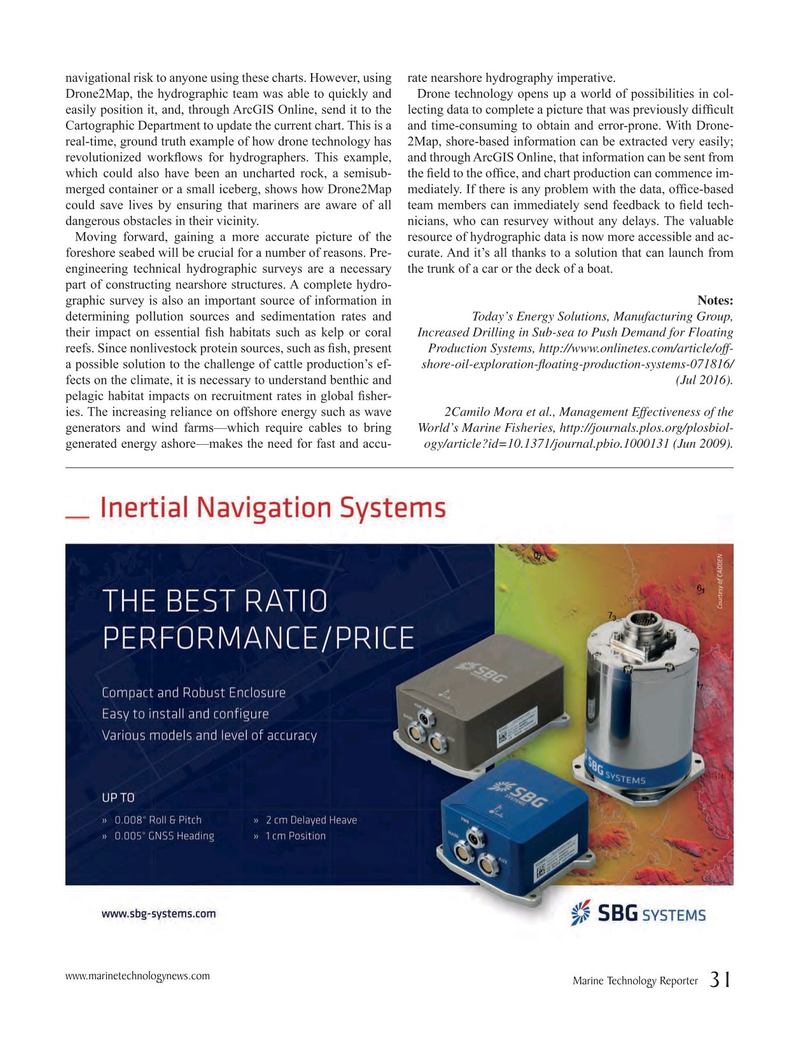
Page 31: of Marine Technology Magazine (September 2016)
Ocean Observation: Gliders, Buoys & Sub-Surface Networks
Read this page in Pdf, Flash or Html5 edition of September 2016 Marine Technology Magazine
navigational risk to anyone using these charts. However, using rate nearshore hydrography imperative.
Drone2Map, the hydrographic team was able to quickly and Drone technology opens up a world of possibilities in col- easily position it, and, through ArcGIS Online, send it to the lecting data to complete a picture that was previously dif? cult
Cartographic Department to update the current chart. This is a and time-consuming to obtain and error-prone. With Drone- real-time, ground truth example of how drone technology has 2Map, shore-based information can be extracted very easily; revolutionized work? ows for hydrographers. This example, and through ArcGIS Online, that information can be sent from which could also have been an uncharted rock, a semisub- the ? eld to the of? ce, and chart production can commence im- merged container or a small iceberg, shows how Drone2Map mediately. If there is any problem with the data, of? ce-based could save lives by ensuring that mariners are aware of all team members can immediately send feedback to ? eld tech- dangerous obstacles in their vicinity. nicians, who can resurvey without any delays. The valuable
Moving forward, gaining a more accurate picture of the resource of hydrographic data is now more accessible and ac- foreshore seabed will be crucial for a number of reasons. Pre- curate. And it’s all thanks to a solution that can launch from engineering technical hydrographic surveys are a necessary the trunk of a car or the deck of a boat.
part of constructing nearshore structures. A complete hydro- graphic survey is also an important source of information in Notes: determining pollution sources and sedimentation rates and Today’s Energy Solutions, Manufacturing Group, their impact on essential ? sh habitats such as kelp or coral Increased Drilling in Sub-sea to Push Demand for Floating reefs. Since nonlivestock protein sources, such as ? sh, present Production Systems, http://www.onlinetes.com/article/off- a possible solution to the challenge of cattle production’s ef- shore-oil-exploration-? oating-production-systems-071816/ fects on the climate, it is necessary to understand benthic and (Jul 2016).
pelagic habitat impacts on recruitment rates in global ? sher- ies. The increasing reliance on offshore energy such as wave 2Camilo Mora et al., Management Effectiveness of the generators and wind farms—which require cables to bring World’s Marine Fisheries, http://journals.plos.org/plosbiol- generated energy ashore—makes the need for fast and accu- ogy/article?id=10.1371/journal.pbio.1000131 (Jun 2009).
www.marinetechnologynews.com
Marine Technology Reporter 31
MTR #7 (18-33).indd 31 8/24/2016 12:35:43 PM

 30
30

 32
32
